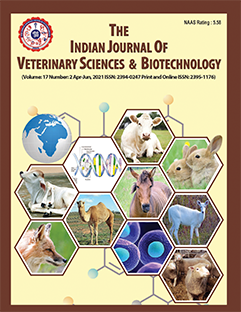Epidemiology of Schistosoma and Gastrointestinal Parasites in Goats: A Slaughterhouse-Based Study from Malwa Region, Madhya Pradesh, India
DOI:
https://doi.org/10.48165/ijvsbt.21.4.32Keywords:
Epidemiological dynamics, Gastrointestinal parasites, Goat, Parasitic burden, Schistosoma sppAbstract
Gastrointestinal (GI) parasitic infections, including those caused by Schistosoma species, represent a major constraint to goat health and productivity. This research aimed to elucidate the prevalence and epidemiological dynamics of Schistosoma and other GI parasites in goats slaughtered in the Malwa region of Madhya Pradesh, India. A total of 312 fecal and mesenteric tissue samples were systematically collected from goats at the Mhow Cantonment Slaughterhouse during the summer and monsoon seasons of 2024. Diagnostic assessments were performed using flotation, sedimentation, and McMaster techniques, supplemented by morphological identification of Schistosoma worms and eggs. The findings revealed a significantly higher prevalence of GI parasites during the monsoon season (p<0.05), with Eimeria spp. (63.14%) and strongyles (59.29%) predominating. Schistosoma indicum was detected in 1.60% of the sampled goats. Males demonstrated a markedly higher prevalence of parasitism (70.08%) compared to females (53.84%, p<0.05), while adults (66.66%) exhibited a higher infection rate than kids (37.5%, p<0.01). Breed-specific differences were also observed, with Jamunapari goats exhibiting the highest prevalence (71.60%), followed by Sirohi, Barbari, and Beetal breeds. The highest parasite intensities were recorded for Eimeria spp. (2377 ± 226 EPG) and strongyles (2329 ± 230 EPG), with comparatively lower counts for Trichuris, Fasciola, and Schistosoma spp. The study highlights the significant burden of GI parasitism in goats and underscores the need for targeted and season-specific control strategies to enhance animal health and productivity in the Malwa region.
Downloads
References
1. Agrawal, M.C. (1999). Schistosomosis, an underestimated problem in animals in South Asia. World Animal Review, 92, 55–57.
2. Agrawal, V., Garg, U.K., Shukla, M.K., & Das, G. (2013). Prevalence of Schistosoma spindale in ruminants in Malwa region of Madhya Pradesh. Ruminant Science, 2, 73–74.
3. Akther, M. (2015). Pathoprevalence of infectious diseases of goat emphasizing on endoparasitic lesions at Dinajpur Sadar. Master’s Thesis, Pathology. Hajee Mohammod Danesh Science and Technology University, Dinajpur, Rangpur, Bangladesh.
4. Angora, E.K., Allienne, J.F., Rey, O., Menan, H., Touré, A.O., Coulibaly, J.T., et al. (2019). High prevalence of haematobium × bovis hybrids in school children in Côte d’Ivoire. Parasitology, 147, 287–294.
5. Cherian, S., & D’Souza, P.E. (2009). Coprological diagnosis of ovine schistosomosis by different laboratory techniques. Veterinary World, 2, 271–273.
6. Jas, R., Kumar, D., Bhandari, A., & Pandit, S. (2017). Seasonal alteration in prevalence and intensity of naturally occurring gastrointestinal helminth infection in goats of new alluvial zone of West Bengal, India. Biological Rhythm Research, 48(6), 867–876.
7. Jeyathilakan, N., Latha, B.R., & Basith, S.A. (2008). Seasonal prevalence of Schistosoma spindale in ruminants at Chennai. Tamilnadu Journal of Veterinary and Animal Sciences, 4, 135–138.
8. Kouadio, J.N., Giovanoli Evack, J., Achi, L.Y., & Tano, Y. (2020). Prevalence and distribution of livestock schistosomiasis and fascioliasis in Côte d’Ivoire: Results from a cross-sectional survey. BMC Veterinary Research, 16, 446.
9. Pal, P., Chatlod, L.R., & Avasthe, R.K. (2017). Seasonal prevalence of gastrointestinal parasites of goats in North-East Himalayan region of Sikkim, India. The Indian Journal of Animal Sciences, 87(5), 558–561.
10. Rahman, W.A. (1994). Effect of subclinical Eimeria species infections in tropical goats subsequently challenged with caprine Haemonchus contortus. Veterinary Record, 134(10), 236–237.
11. Ravindran, R., Lakshmanan, B., Ravishankar, C., & Subrmanian, H. (2007). Visceral schistosomiasis among domestic ruminants slaughtered in Wayanad, South India. Southeast Asian Journal of Tropical Medicine and Public Health, 38, 1008–1010.
12. Singh, E., Kaur, P., Singla, L.D., & Bal, M.S. (2017). Prevalence of gastrointestinal parasitism in small ruminants in western zone of Punjab, India. Veterinary World, 10(1), 61–65.
13. Sorathiya, L.M., Fulsoundar, A.B., Rao, T.K.S., & Kumar, N. (2017). Prevalence and risk factors for gastrointestinal parasitism in traditionally maintained goat flocks of South Gujarat. Journal of Parasitic Diseases, 41, 137–141.
14. Soulsby, E.J.L. (1982). Helminths, Arthropods and Protozoa of Domesticated Animals (7th ed.). London, UK: Bailliere Tindall.
15. Sumanth, S., D’Souza, P.E., & Jagannath, M.S. (2004). A study of nasal and visceral schistosomosis in cattle slaughtered at an abattoir in Bangalore, South India. Revue Scientifique et Technique - Office International des Epizooties, 23(3), 937–942.
Downloads
Published
Issue
Section
License
Copyright (c) 2025 Indian Journal of Veterinary Sciences and Biotechnology

This work is licensed under a Creative Commons Attribution-NonCommercial-NoDerivatives 4.0 International License.




